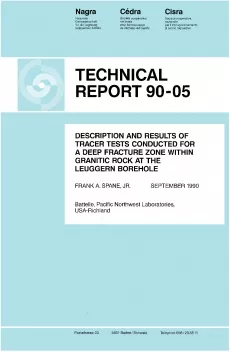
Technical Report NTB 90-05
Description and results of tracer tests conducted for a deep fracture zone within granitic rock at the Leuggern borehole
A tracer test program was planned at the Leuggern borehole, to provide hydrogeologic information concerning the fracture zone(s) intersected within the depth interval 1'634.9 – 1'688.9 m. The original design of the tracer-dilution test was to: establish a uniform tracer concentration within the test system, and then monitor (at ground surface) the decline of tracer concentration within the circulated test system fluid. Analysis of the tracer concentration decline pattern was expected to provide an estimate of the natural lateral flux and lateral hydraulic gradient for the isolated test interval. A later pump-back test was also designed to recover tracer that had been "flushed" into the test section, during the previous closed circulation period. Analysis of the tracer recovery pattern was expected to provide an estimate of the dispersivity within the intersected fracture system.
Originally the "tracer-dilution" test was planned to have one tracer injection and removal phase. Results obtained during the first tracer (i.e. Uranine) injection and a subsequent, second tracer (Eosin) injection, however, indicated that a natural vertical hydraulic gradient existed within the borehole test section. Because of the presence of the natural vertical hydraulic gradient, the original test program was modified and a third tracer injection (Naphtionate) and tracer recovery test phase (also referred to as the natural outflow/discharge test) was implemented.
The entire Leuggern tracer test program was conducted between July 5 to December 23, 1988; with the individual Uranine, Eosin, and Naphtionate tracer injection/recovery phases occurring between July 5 to September 2, September 2 to October 31, and October 31 to December 23, 1988, respectively. Following completion of the Naphtionate tracer injection phase on November 17, a natural outflow/discharge test was implemented to recover tracers injected during the previous three injection phases (i.e. 1st injection = Uranine, 2nd = Eosin, 3rd = Naphtionate). To facilitate the recovery of injected tracers, a downhole valve within the central tubing string was opened prior to the start of the natural outflow/discharge phase. The natural outflow/discharge phase was completed over the period 17 November to 23 December, 1988. During the thirty-six day discharge test period, approximately 62 % (12.9 grams) of Naphtionate, 47 % (8.7 grams) of Eosin, and 49 % (38.3 grams) of Uranine were recovered. A total volume of 640'000 liters of water was removed during the natural outflow/discharge test phase, with flow rates declining from an initial high of 35 L/min to an observed 11.2 L/min at test termination.
Results obtained from "arrival-time" information during the Eosin and Naphtionate injection/recovery phases indicate a downward vertical flow of approximately 195 – 225 ml/min in the isolated interval, from an upper fracture inflow zone to a lower fracture outflow zone. Through analysis of the dilution levels of Uranine and Eosin during the injection/recovery periods, and review of field data, the top of the upper inflow zone was determined to be approximately 13 m below the top flow line and the bottom of the outflow zone to be approximately 3 to 5 meters above the bottom flow line.
Hydraulic analysis of the flow rate data during the natural outflow/discharge phase and subsequent pressure recovery following termination of the test indicated that the test zone exhibited a heterogeneous formation, "double-porosity" response behavior. Calculated transmissivity (T) and storativity (S) values for the fracture/shear zone and total system (i.e. fracture zone and matrix) from the flow-rate test analysis are: T = 6.1 x 10-5 m2/s and 6.4 x 10-5 m2/s, and S = 4.5 x 10-5 and 1.5 x 10-4, respectively. Transient analysis of the pressure recovery response provided an estimate for transmissivity of 7.1 x 10-5 m2/s, which is in close agreement with the flow-rate analysis test results.
